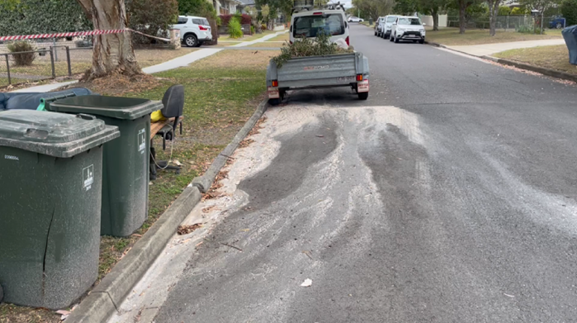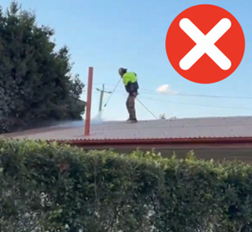Asbestos cement roofs are particularly concerning as they are in the poorest condition of all asbestos materials remaining in the built environment, posing a relatively high asbestos exposure risk.
Why are asbestos cement roofs dangerous?
Asbestos cement roofs are in poor condition after being directly exposed to years of sun, wind, rain and hail, as well as more extreme weather events. This means that asbestos roofs release fibres more easily and therefore extra care needs to be taken when working on asbestos roofs. Heavy rains can wash fibres into guttering, contaminating surrounding areas.
As asbestos roofs age, they also become brittle, increasing the risk of breakage and even collapse.
Weathered asbestos cement roof with mould and lichen
Hail damage and exposed bundles of asbestos fibres on asbestos cement roof
Working on asbestos cement roofs
It is illegal in every state of Australia to use high pressure water spray or compressed air on asbestos materials.
It is also illegal to use power tools or other equipment such as brooms on asbestos-containing materials in an uncontrolled manner, as this also releases asbestos fibres into the air.
In recent years there have been numerous incidents where property owners have tried to clean their asbestos roofs using high pressure water, leading to extensive contamination that has cost hundreds of thousand dollars to rectify and heavy fines for the persons undertaking the work.
The asbestos fibres released by cleaning activities often end up also contaminating neighbours’ properties, vegetation and soil surrounding the property, public footpaths, roads and stormwater systems.
Incidents have also occurred where individuals have fallen through or off asbestos roofs while undertaking maintenance work.

Photo credit: Workplace Health and Safety Queensland - Asbestos debris flowing down the street and entering the stormwater system

Queensland Government
Cleaning asbestos roofs
Preparing and painting corrugated asbestos cement roof and fences
SafeWork NSW
Western Australia Government
Guidance Note on Asbestos Cement Roofs
Asbestos cement roof hotspots
In 2021 ASSEA completed a residential asbestos roof hotspot mapping project which targeted 56 areas of interest across Australia, covering 770 km2.
Within these areas approximately 13,000 buildings with asbestos roofing were identified using a combination of high-resolution aerial imagery and artificial intelligence, amounting to around 23,000 tonnes or 1.4 million square metres of residential asbestos roofing – equivalent to 213 football fields.

